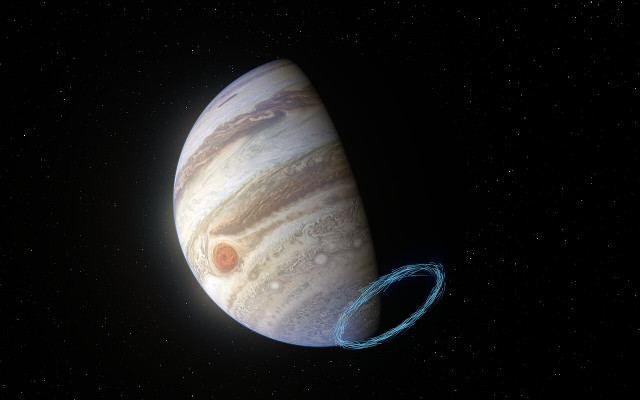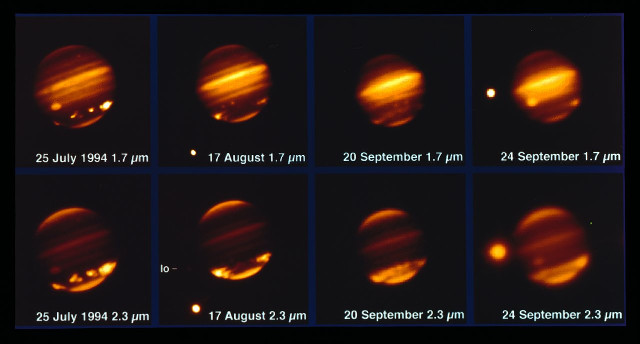
An article published in the journal “Astronomy & Astrophysics” reports the first direct measurement of the speed of winds in the central region of the planet Jupiter’s atmosphere. A team of researchers led by Thibault Cavalié of the Laboratoire d’Astrophysique de Bordeaux in France found a way to measure the velocity of winds in the stratosphere in the area hit by comet Shoemaker-Levy 9 in July 1994. Years later, hydrogen cyanide molecules released into the Jovian atmosphere continue to travel together with the winds, and these movements are detectable in the emissions captured by the ALMA radio telescope. The result is that these winds reach 1450 kilometres an hour near Jupiter’s poles.
Astronomers can follow the movement of winds in Jupiter’s lower atmosphere thanks to the red and white bands on its surface. The polar auroras, on the other hand, are associated with strong winds in the upper part of the atmosphere. In between is the stratosphere, but so far there was no way to measure the speed of the winds because it’s cloudless.
In 1994, comet Shoemaker-Levy 9 crashed into Jupiter in one of the most-watched astronomical events of the century, and the impact scattered molecules not normally found on Jupiter such as hydrogen cyanide into its atmosphere. Here are the much sought-after clouds with a spectroscopic signature detectable in the emissions reaching the Earth.
The ALMA (Atacama Large Millimeter/submillimeter Array) radio telescope, inaugurated in March 2013, made it possible to trace the movements of hydrogen cyanide in various directions. Vertical displacements were also detected thanks to the Doppler effect which slightly but measurably altered the wavelengths.
The measurements took less than 30 minutes of the ALMA radio telescope’s time, confirming its extraordinary characteristics. Calculations based on the observations conducted indicate that winds in the polar regions can reach 1450 kilometres an hour. The researchers were also able to confirm the existence of strong atmospheric winds around Jupiter’s equator with average speeds around 600 kilometres an hour.
The top image (ESO/L. Calçada & NASA/JPL-Caltech/SwRI/MSSS) shows Jupiter and an artistic representation of the winds in its South Pole region.
Thomas Greathouse of the Southwest Research Institute, one of the authors of this study, explained that the results obtained thanks to the ALMA radio telescope open a new window for studying Jupiter’s auroral regions that was truly unexpected just a few months ago. He added that they lay the groundwork for similar but more extensive measurements to be made by ESA’s JUICE (JUpiter ICy moons Explorer) mission with the space probe’s Submillimeter Wave Instrument.
The Extremely Large Telescope (ELT) is another telescope that will be used to study Jupiter when it enters service in a few years. New possibilities continue to be added in the study of phenomena that are extreme and impossible on Earth but normal on Jupiter.


